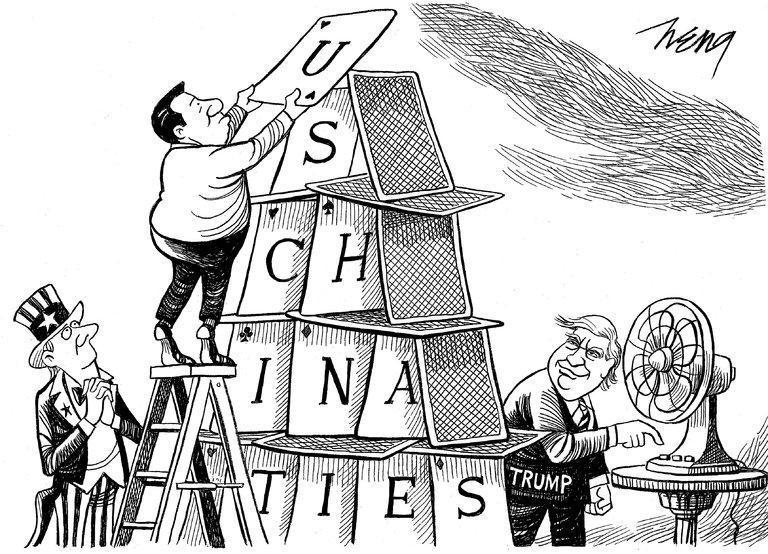Donald Trump has plenty of space for hawkishness on China
It is probably too much to suggest that US President Donald Trump has a grand strategy, but he does have a single overriding strategic instinct. That instinct can be summed up as: Cool tensions with Russia in order to more aggressively confront China.
Of course, as the President has discovered to his frustration, being the head of the federal government is very different from running a privately-held real estate and branding enterprise. The President’s instincts do not automatically become formal strategy, let alone set the terms of engagement for the rest of the world. And indeed, Trump’s attempts to ease tensions with Russia have largely come to naught: Whatever the reason for his docility towards Vladimir Putin, there simply is no backing in Congress or the civil service for a relationship on the terms that Putin would want. Or, as one Republican on Capitol Hill put it to me, “You couldn’t fill a minivan with the pro-Russia group in Congress.”
So while Trump has been extraordinarily deferential towards Putin, and while his administration has slow-rolled various punitive measures demanded by Congress, the strategic position of Washington vis-à-vis Moscow has not undergone a radical change since the change in American administrations. At the operational level, the US continues to work with its traditional allies, rotate forces through Europe and otherwise continue to view Russia as an adversary rather than trying to make it into a partner.
Things are different with respect to China. There, Trump is operating much more in line with the general perspectives of the American foreign policy community, which has become increasingly wary of expanding Chinese influence abroad and more aware of its authoritarian tendencies at home. The Obama administration attempted, with its “rebalance” towards the Pacific and with the Trans-Pacific Partnership, to strengthen its position against Beijing by building a multilateral network of alliances in the Asia-Pacific. While Obama and his advisors would actively avoid the term “containment”, the purpose of their strategy was to build and multiply American power throughout the Pacific in order to maintain American primacy against China.
But American hawkishness towards China has sharpened significantly since the “rebalance” was announced in 2012 – a trend which both precedes and extends beyond the purview of the current President. Part of this comes down to growing awareness of specific clashes between the two powers, but it is also explained by the breadth of the challenge that the China presents to the US. For conservatives interested in maintaining American military supremacy, China’s rapid military buildup and belligerence towards long-standing American allies like Japan and Taiwan presents a clear strategic rationale.

For progressives, China’s poor human rights record is a major issue, as is the threat to American jobs by Chinese manufacturing. Of course there are conservative critics of China’s human rights record and progressives alarmed by its military buildup as well – but the fundamental point is that China offers something to justify opposition from across the American ideological spectrum, resulting in a rare point of (relative) foreign policy consensus. That dynamic serves to drive outcomes towards confrontation and limits the possibility of a broader rapprochement.
Nor does Trump face substantial obstacles from public opinion. The US public is not notably warm towards China – in 2018, Pew Research found the percentage of Americans who have a favorable opinion of it stood at 38%, a decline from 44% in 2017.
To the extent that Trump has to exercise caution, it is with respect to the second- and third-order effects of a more hawkish approach: The Chinese government has specifically targeted its countermeasures against Trump’s tariffs against his political base, for instance by banning the import of American soybeans grown in Midwestern swing states such as Iowa. Such a tactic may well work – the Democrats made key gains in the midterm elections in those states last November, and it has recently been reported that Trump’s own internal polling shows him badly tailing former Vice President Biden there as well. But that strategy can only be truly tested on 3 November 2020 – until then its effectiveness relies on the extent to which Trump believes it.

What Trump believes, of course, is the crux of the matter. Trump’s attitude towards China is split between his threat perception and his desire to strike big deals with powerful world leaders. That cognitive dissonance is on full display in his tweets and public statements about China, where he draws a distinction between his “friend” Xi Jinping with whom he shares a close, personal bond and the generic “China” which is an implacable enemy of the American people.
The first few years of Trump’s administration have been marked by his vacillation between those two poles, with promises of an all-encompassing trade deal followed by threats of massive new tariffs followed in turn by walking back those threats. This pattern could continue for some time to come, and, indeed, given the breadth of American skepticism about the US-China relationship, that seems the most likely outcome.
